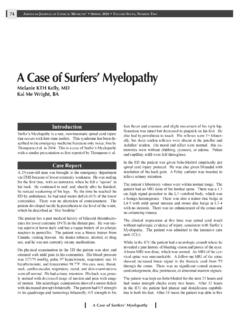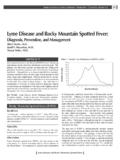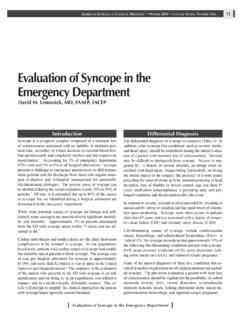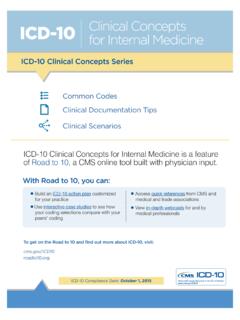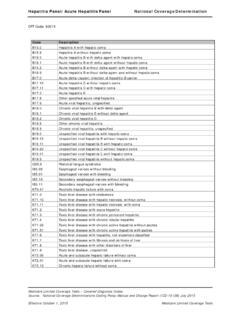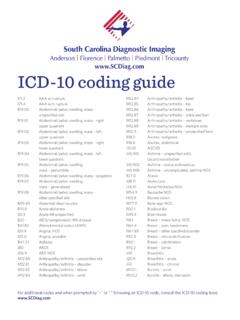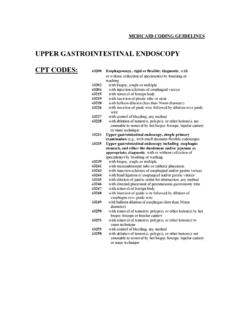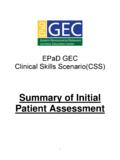Transcription of Obstetric Emergencies
1 AmericAn JournAl of clinicAl medicine Spring 2009 Volume Six, number Two42 Obstetric EmergenciesObstetric EmergenciesDaniel M. Avery, MDAbstractNo specialty of medicine is more inundated with Emergencies than obstetrics. This paper describes a number of the more common Obstetric Emergencies from a practical and rural prac-titioner standpoint. Obstetrics is unique in that there are two patients to consider and care for. This paper discusses basic emergency care, Obstetric and fetal assessment, preterm labor, premature rupture of membranes, severe preeclampsia, eclamp-sia, prolapsed umbilical cord, antepartum hemorrhage, abortion with hemorrhagic shock, ectopic pregnancy with shock, acute abdominal pain during pregnancy, DIC, uterine inversion, post-partum hemorrhage, retained placenta, abdominal pregnancy, shoulder dystocia, amniotic fluid embolism, trauma, CPR during pregnancy, postmortem cesarean section, cesarean section with local or no anesthesia, and transport of the Obstetric obstetrics there are two patients to care for instead of one, a mother and a baby or fetus.
2 The management of one patient heavily affects the management of the other. Sometimes the decision has to be made to care for one patient at the expense of the other; , care for the mother first. The second patient (the fetus) may be viable or Emergency CareBasic care of the patient(s) includes the ABCs of resuscitation: airway, breathing, and circulation. The patient should be quick-ly assessed, as much history obtained as possible, and a quick physical examination performed. Are vital signs stable? Is the patient in shock? IV access should be obtained, and two large bore IVs placed, if there is active bleeding. Does the patient (and baby) need oxygen? What laboratory and radiographic studies are needed? How much blood does the blood bank have at this institution? Obstetric AssessmentDid anyone come with the patient? Is the patient conscious?
3 Are there signs of external trauma? Is there active bleeding? Is the patient in pain ? Is the patient in labor? How far along is the pregnancy? Most patients receiving prenatal care can tell their due date, if conscious. If not, does the patient look term or preterm? Are there fetal heart tones? A bedside ultrasound, if available, can provide gestational age, viability, if the preg-nancy is alive, presentation, placental localization, number of fetuses, etc. If there is only one fetus, measuring the fundal height should correspond to weeks of AssessmentIf the pregnancy is viable, can the patient and baby be cared for at this institution or does the patient need to be transferred to a higher level of care? Are Obstetric services available at all at this institution? What is the availability of someone to care for the baby if it needs to be delivered?
4 Are there pediatricians and a nursery or neonatologists and a high-risk nursery avail-able? Is anesthesia available? Does the patient need tocolysis, Betamethasone, or Group B Strep prophylaxis? Can the baby be monitored?Preterm Labor and DeliveryThe number one obstetrical problem worldwide is preterm la-bor and delivery. Preterm delivery is defined as delivery before 37 weeks gestation. No other single problem costs healthcare systems worldwide more healthcare dollars. Preterm deliver-ies comprise about 10% of all deliveries but comprise 85% of neonatal morbidity and mortality. Preterm labor demands an aggressive approach to stop labor, determine the cause, and pre-vent delivery. An effort should be made to determine the cause, although 50% of the time the etiology is not labor is treated with tocolysis, usually Magnesium sulfate or terbutaline.
5 If the gestation is less than 34 weeks, Betamethasone is given to accelerate lung maturity should the tocolysis fail. Prophylaxis for Group B Strep is given. The decision should be made if the patient is stable and needs to be transferred to a higher level of care or because no obstetrics services are available. Often the decision will need to be made as to stabilize and transfer the patient or stabilize and deliver the patient, then transfer mother and baby. Pregnant women in labor should be transferred by ambulance or helicopter, depend-ing on the availability and weather. AmericAn JournAl of clinicAl medicine Spring 2009 Volume Six, number Two43 Obstetric EmergenciesIf the patient is in labor, a labor and delivery nurse should ac-company the patient in the ambulance. If delivery is immi-nent or likely en route, the obstetrician or a physician capable of performing a vaginal delivery should ride with the patient.
6 For helicopter transports, there is usually not room for a physi-cian or even a nurse to accompany the patient. Most helicopter transports will be equipped with a physician and nurse capable of managing a vaginal delivery delivery is imminent in an institution in which there are no Obstetric services at all. A physician capable of perform-ing a vaginal delivery and a nurse should accompany the patient in transport. Today, most tertiary and quaternary institutions will not accept the transfer of a pregnant laboring patient without both physician accompanying the patient and the patient signing a waiver of liability to the accepting institution. Many accepting institutions require that the patient be stable prior to to tocolysis include cardiac disease, severe fetal anomalies, hyperthyroidism, severe migraine headache, uncontrolled diabetes, advanced cervical dilatation and fetal Fetal distress should be managed prior to transfer, if at all possible.
7 Prophylactic tocolysis is often used during transfer, if not contraindicated, to minimize the risk of delivery en Rupture of MembranesPremature rupture of membranes is a second important obstet-ric emergency. Fluid coming from the vagina is ruptured mem-branes until proven otherwise. The diagnosis is made by sterile speculum examination with nitrazine, pooling, ferning and/or ultrasound estimation of amniotic fluid volume. Amniocentesis with instillation of methylene blue may also be used to make the diagnosis. At sterile speculum examination, dilatation of the cer-vix should be noted. A closed cervix as opposed to a completely dilated cervix with impending delivery will affect delivery imminent? What is the presenting part? Is the fetus viable? What is the gestational age? Ultrasound can be used to answer these questions. Much the same as preterm labor, can this patient be cared for in this institution or does she need to be transferred?
8 Will she need to be delivered and stabilized first, then transferred?Severe PreeclampsiaSevere preeclampsia is also an Obstetric emergency demanding immediate treatment. A systolic blood pressure of 160 mm Hg or diastolic of 110 mm Hg needs immediate intervention. The diagnosis of severe PIH is also made by proteinuria of 5 grams on a 24-hour collection or +3 on a dipstick of a random speci-men. Oliguria of <500 cc urine output over 24 hours, any CNS symptoms, pulmonary edema or cyanosis, impaired liver func-tion tests, low platelets, intrauterine growth restriction, or right upper quadrant abdominal pain also confirm the cure for severe preeclampsia is delivery, regardless of ges-tational age. Magnesium sulfate is used to prevent seizures, hydralazine to control blood pressure after the loading dose of magnesium, and Lasix reserved for pulmonary edema.
9 Diuret-ics are used only for pulmonary edema and congestive failure, due to their increased risk of precipitating a pulmonary em-bolus. A vaginal delivery is hoped for, and cesarean section is used for failed inductions, malpresentations, or worsening blood Magnesium is continued for at least 24 hours postpartum and often 48 hours. Preeclampsia can develop up to two weeks postpartum. Therapeutic levels of magnesium are in the 4-6 range with levels obtained every six hours usually. If the crea-tinine is or above, reduce the magnesium infusion rate by 50%.2 The higher the infusion rate of magnesium, the more frequently magnesium levels are is generalized seizures occurring usually with preec-lampsia. They are antepartum 50% of the time and 91% occur after 28 weeks. The differential diagnosis includes epilepsy, uncontrolled hypertension, lupus, intracranial hemorrhage, brain tumors, aneurysms, ITP, Metabolic Disorders, Cerebral Vasculitis, Cavernous Vein Thrombosis, Postdural Puncture, CVA, and inadvertent vascular injection of anesthetic used for epidural The latter is usually accompanied by a metallic taste, an aura, and strange feeling before imaging is not always necessary unless there are fo-cal changes, the seizures recurrent, deterioration of the patient s condition, or the need to exclude other Usually the cure is delivery, and it should not be withheld for Betametha-sone.
10 Avoid diuretics unless there is pulmonary edema. Restrict fluids to reduce the incidence of cerebral edema. The treatment is magnesium sulfate. If the patient is on magnesium and seiz-ing, then more magnesium is needed. Rarely, is a second line anticonvulsant needed. Hydralazine and labetolol are used to treat blood pressure. Nitroglycerine may be necessary postpar-tum. Systolic blood pressures > 160 mm Hg and diastolic > 110 mm Hg increase the likelihood of Umbilical CordA prolapsed umbilical cord is an Obstetric emergency in which compression of the umbilical cord can have fatal results if not relieved quickly. If the membranes are not ruptured, a cord pre-sentation, as it is called, is a disaster waiting to happen. Com-pression of the cord by the presenting part compresses umbili-cal vessels, causing hypoxia. The diagnosis is made by fetal heart rate tracing and vaginal examination.

